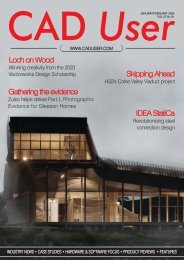DM1907
You also want an ePaper? Increase the reach of your titles
YUMPU automatically turns print PDFs into web optimized ePapers that Google loves.
TECHNOLOGY FOCUS: MICROFILM Dm<br />
"DOCUMENTS ON MICROFILM ARE OFTEN OF POOR QUALITY. JUST BECAUSE THEY HAVE BEEN DIGITISED<br />
DOESN'T MEAN THAT THE DIGITISED VERSION IS READABLE. DESTROYING THE ORIGINAL MICROFILM AFTER<br />
DIGITISATION IS STRONGLY DISCOURAGED, BUT IF THAT IS THE INTENT, THEN IT WILL BE NECESSARY TO INSPECT<br />
100% OF THE DIGITISED IMAGES PRIOR TO THE FILM'S DESTRUCTION. IT IS COMMON FOR A FILM COLLECTION<br />
TO CONTAIN MANY MILLIONS OF DOCUMENT IMAGES, BUT IF THE DIGITAL COPY OF JUST 1 MILLION<br />
DOCUMENTS WERE INSPECTED, SPENDING JUST 1 SECOND ON EACH WOULD TAKE A MINIMUM OF 277 MAN-<br />
HOURS TO COMPLETE."<br />
space than 8-bit files. However, if the<br />
document image on film is of poor<br />
quality, which is frequently the case,<br />
to capture all image detail, it may be<br />
necessary to use 8-bit grayscale.<br />
7) Dot Per Inch (DPI): DPI affects both<br />
image clarity and file size. A typical<br />
value is 300 dpi. Higher DPI may<br />
improve image clarity but will increase<br />
required storage space.<br />
8) Quality Assurance: Documents on<br />
microfilm are often of poor quality.<br />
Just because they have been digitised<br />
doesn't mean that the digitised version<br />
is readable. Destroying the original<br />
microfilm after digitisation is strongly<br />
discouraged, but if that is the intent,<br />
then it will be necessary to inspect<br />
100% of the digitised images prior to<br />
the film's destruction. It is common for<br />
a film collection to contain many<br />
millions of document images, but if<br />
the digital copy of just 1 million<br />
documents were inspected, spending<br />
just 1 second on each would take a<br />
minimum of 277 man-hours to<br />
complete. Nonetheless, 100%<br />
inspection is not 100% accurate.<br />
100% inspection will be a major<br />
expense of the digitisation process<br />
and in many cases, it is impractical.<br />
For this reason, it is suggested that<br />
the film always be retained, thereby<br />
making the inspection step<br />
unnecessary. If while using the<br />
digitised images, it is discovered that<br />
the quality of an image is<br />
unacceptable the film can then be<br />
used to re-digitise and replace the<br />
unacceptable image.<br />
9) Hardware: Hardware will be needed<br />
to accomplish three tasks. The first is<br />
the actual digitisation. The second is<br />
to store, serve, and backup the files.<br />
The third is to accomplish re-scans<br />
when a digitised image is found to be<br />
unacceptable.<br />
10) Software: Depending on the file<br />
format chosen, it may be necessary to<br />
purchase a proprietary viewer for each<br />
computer needing access to the<br />
digitised images. This software<br />
frequently includes recurring software<br />
charges. Therefore, proprietary file<br />
formats are not recommended.<br />
11) Cost: The cost of digitising<br />
microfilm is influenced by many<br />
factors such as how many images are<br />
to be digitised, do the images need to<br />
be 100% inspected, what level of<br />
granularity is needed for indexing,<br />
hardware costs, storage/server costs,<br />
recurring software charges, recurring<br />
storage/server charges, etc.<br />
If all this seems overwhelming, take<br />
comfort in the fact that you are not<br />
alone. At this point in the evolution of<br />
microfilm digitisation technology, the<br />
best digitisation path is frequently not<br />
clear. In fact, for many institutions,<br />
practically speaking, a path does not<br />
exist. e-ImageData is dedicated and<br />
focused on changing that - making<br />
the pathway to digitisation clearer and<br />
within reach for everyone.<br />
As industry leaders in micrographics<br />
for the past 3 decades, we at e-<br />
ImageData are continually improving<br />
the way people work with microfilm<br />
worldwide by providing the latest<br />
technologies available. We are excited<br />
to be on the brink of yet another<br />
extraordinary technology that will<br />
make digitising microfilm easier, more<br />
accurate, more accessible, and more<br />
affordable than ever before.<br />
More info: www.e-imagedata.com<br />
www.document-manager.com<br />
July/August 2019<br />
@DMMagAndAwards<br />
29

















